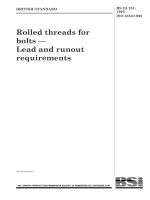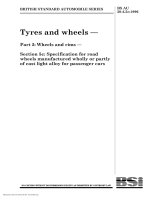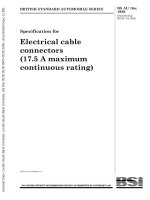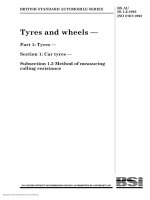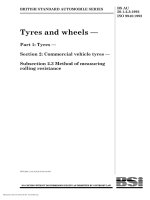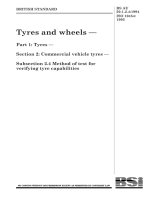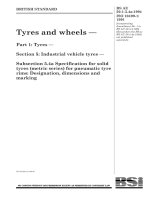Bsi bs au 237a 1993 (1999)
Bạn đang xem bản rút gọn của tài liệu. Xem và tải ngay bản đầy đủ của tài liệu tại đây (488.88 KB, 16 trang )
BRITISH STANDARD
Specification for
Light domestic duty
jumper lead sets for
automotive starting
BS AU 237a:
1993
BS AU 237a:1993
Committees responsible for this
British Standard
The preparation of this British Standard was entrusted by the Automobile
Standards Policy Committee (AUE/- ) to Technical Committee AUE/9, upon
which the following bodies were represented:
Automobile Association
Consumer Policy Committee of BSI
Department of Trade and Industry (Consumer Safety Unit, CA Division)
Department of Transport
Garage Equipment Association
Institute of Trading Standards Administration
Motor Cycle Industry’s Association of Great Britain Ltd.
Petrol Pump Manufacturers’ Association
Royal Automobile Club
Society of Motor Manufacturers and Traders Ltd.
This British Standard, having
been prepared under the
direction of the Automobile
Standards Policy Committee,
was published under the
authority of the Standards
Board and comes
into effect on
1 5 September 1 993
© BSI 07- 1 999
First published as BS AU 237- 1 ,
December 1 990
Second edition September 1 993
The following BSI references
relate to the work on this
standard:
Committee reference AUE/9
Draft for comment 92/76371 DC
ISBN 0 580 22432 5
Amendments issued since publication
Amd. No.
Date
Comments
BS AU 237a:1993
Contents
Page
Committees responsible
Foreword
Inside front cover
ii
1
Scope
1
2
References
1
1
3
Definitions
4
Cable and construction
1
5
Clips
1
6
Resistance to contamination
2
7
Marking
2
8
Container
2
Annex A (normative) Tests for j umper lead sets
5
Annex B (normative) Test fluids and conditioning
8
Annex C (normative) Safety and operating instructions
for the use of j umper leads
9
Figure 1 — Typical j umper lead
3
Figure 2 — Marking symbols
4
Figure A. 1 — Schematic drawing of test circuit for
electrical tests
6
Figure A. 2 — Schematic drawing for cable termination
testing
7
Figure A. 3 — Schematic drawing for flame retardance
test
List of references
© BSI 07- 1 999
8
Inside back cover
i
BS AU 2 3 7a: 1 993
Fore word
This British Standard has been prepared under the direction of the Automobile
Standards Policy Committee to establish a standard of performance for j umper
lead sets for automotive j ump starting.
BS AU 237a deals with requirements for j umper lead sets for use when starting
an internal combustion engine from a supplementary battery. Examples are
motor vehicles, boats and other installations.
The standard is applicable to 1 2 V vehicle systems.
This second edition of BS AU 237 supersedes BS AU 237- 1 : 1 990 which is
withdrawn. It constitutes a technical revision undertaken to improve and clarify
testing procedures arising from the application of the first edition for conformity
testing purposes. At the same time the title of the standard has been amended to
reflect the fact that Part 2 for heavy domestic duty and Part 3 for commercial
vehicles have not been developed and the need for such Parts are no longer
considered necessary.
Product certification.
Users of this British Standard are advised to consider the
desirability of third party certification of product conformity with this British
Standard based on testing and continuing product surveillance which may be
coupled with assessment of a supplier’s quality systems against the appropriate
Part of BS 5750.
Enquiries as to the availability of third party certification schemes are forwarded
by BSI to the Association of Certification Bodies. If a third party certification
scheme does not already exist, users should consider approaching an appropriate
body from the list of Association members.
A British Standard does not purport to include all the necessary provisions of a
contract. Users of British Standards are responsible for their correct application.
C omp liance with a British S tand ard d oe s no t of itse lf confe r immunity
from le gal ob ligatio ns.
S ummary of p age s
This document comprises a front cover, an inside front cover, pages i and ii,
pages 1 to 1 0, an inside back cover and a back cover.
This standard has been updated (see copyright date) and may have had
amendments incorporated. This will be indicated in the amendment table on the
inside front cover.
ii
© BSI 07- 1 999
BS AU 2 3 7 a: 1 993
1 S cop e
This British Standard specifies requirements for
jumper lead sets for light domestic use when
starting an internal combustion engine from a
supplementary battery in environmental
temperatures down to – 10 °C. It is restricted to
maximum engine capacity, 3.5 l petrol
and 2.5 l diesel.
Requirements for the safe use of jumper lead sets for
jump starting are given as safety and operating
instructions in Annex C.
2 Re fe re nce s
2 . 1 Normative re fe re nce s
This British Standard incorporates, by reference,
provisions from specific editions of other
publications. These normative references are cited
at the appropriate points in the text and the
publications are listed on the inside back cover
Subsequent amendments to, or revisions of, any of
these publications apply to this British Standard
only when incorporated in it by updating or revision.
2 . 2 Informative re fe re nce s
This British Standard refers to other publications
that provide information or guidance. Editions of
the publications current at the time of issue of this
standard are listed on the inside back cover, but
reference should be made to the latest editions.
3.5
j ump starting
a technique used for assisting the starting of an
internal combustion engine where a healthy and
reasonably well-charged battery is connected
temporarily in parallel with an ailing or discharged
battery of the same nominal voltage to provide
additional cranking power
4 C ab le and construction
4 . 1 Jump e r le ad le ngth
When measured between the ends of the jaws of
each clip, the overall length of the jumper leads as
shown in Figure 1 shall be not less than 3 m.
4 . 2 C ab le constructio n
Any material used for cable construction shall be of
a size capable of carrying 100 A continuously.
4 . 3 C ab le insulation
The cable insulation shall be homogeneous and
shall meet the requirements of type TI 1 of
BS 6746:1990 and of of this standard.
The mean thickness of insulation shall be not less
than 1.3 mm, but it is permissible for the thickness
at any one place to be less than 1.3 mm provided
that the difference does not exceed 0.1 mm + 10 % of
the value specified.
Compliance shall be checked using the method
described in of BS 6469-1.1:1992.
A. 4
8. 1
3 D e finitions
For the purposes of this British Standard, the
definitions given in BS 6604:1985 apply, together
with the following.
3.1
conductor
that portion of a cable which has the specific
function of conveying current
3.2
clip
a device which makes a mechanical and electrical
connection from the conductor to the battery or
earth terminal of a vehicle
3.3
j ump e r le ad se t
a set of two insulated flexible low-voltage conductors
and four insulated clips securely attached to the
ends of the conductors
4 . 4 C o lo ur co ding
A clear distinction shall be made between the two
cables in a jumper lead set by colour coding of the
cables and clips. The cable and clip insulation used
for a positive connection shall be red, and that used
for the negative shall be black.
4 . 5 Te mp e rature range
All cables and conductors shall be designed to
operate within a temperature range of – 25 °C
to + 70 °C.
When tested in accordance with of
BS 6469-1.4:1992 at – 25 °C, the cable insulation
shall show no cracking or rupture visible to the
naked eye, if necessary corrected to give normal
vision, of a trained observer.
8. 1
5 C lip s
5 . 1 D e sign
Clips consisting of a pair of jaws, held together by
and pivoted about a hinged point, shall be fitted
with a spring clamping device to provide force on the
a battery principally used for starting, lighting and jaw holding the clip in a closed position.
ignition on vehicles or plant employing internal
NOTE Designs of clip are optional provided that they meet the
combustion engines
requirements of this standard.
3.4
starte r b atte ry
© BSI 07-1999
1
BS AU 2 3 7a: 1 993
Assessment shall be by visual examination and a
5 . 2 Pe rformance
The clip shall be capable of clamping on and firmly
grasping a horizontal plain stud of a diameter
simple electrical continuity test.
The clips shall meet the requirements of
A. 4 .
of 25 mm which proj ects 1 0 mm from a surrounding
flat surface and shall be capable of resisting a
tensile force equal to the weight of the j umper leads
plus a further 50 N ± 1 N applied in the direction of
the cable.
accordance with
A. 2 .
The voltage drop shall not
exceed 0. 5 V and the measured temperatures shall
not exceed 70 °C. The test shall be repeated using
the two 25 mm × 2 mm copper bars described
A. 2 . 3 . 5 .
Jumper lead sets shall be compatible with the
automotive fuels, lubricants and fluids given in
Annex B.
The clip spring shall not deteriorate when tested in
in
6 Re sistance to contamination
Again, the voltage drop shall not
exceed 0. 5 V and the measured temperatures shall
not exceed 70 °C.
After removal from each fluid, the samples shall be
wiped dry. The samples shall meet the
requirements of the first paragraph of
When tested in accordance with
A. 2
5.2.
the voltage
drop for each lead shall not exceed 0. 5 V and the
temperature shall not exceed 70 °C.
7 Marking
5 . 3 C ab le te rminations
5.3.1
Electrical
All j umper lead sets shall be marked either directly,
or by attachment of a durable non- conducting tag, in
The clip shall be attached by either of the following
a legible and indelible manner. The marking shall
methods.
include the following.
a) The clip shall be clamped or crimped to the
a) Manufacturer’s or distributor’s name or trade
conductor of the cable.
mark.
b) A ring termination shall be crimped to the
b) The number and date of this British Standard,
conductor and bolted to the conducting material
i. e. BS AU 237a: 1 993
of the clip.
1)
.
c) The standard symbols for warning and “read
No portion of the insulation shall be within the zone
instructions before use” in
of crimping or clamping.
BS 5378- 3: 1 982 and
5.3.2
Mechanical
the cable insulation to prevent the j oint being
strained. The j oint shall not break when tested in
A. 3
A. 3 . 1
or
of BS 3641 - 1 : 1 971
(see Figure 2) .
Some form of cable strain relief shall be fitted over
accordance with
1 . 4. 1 7
and, after completion of
A. 2 ,
d) Connect + to + then – to –.
8 C ontaine r
Jumper lead sets shall be supplied in a durable
the voltage drop shall not exceed 0. 5 V and the
container that shall be capable of re- accommodating
measured temperature shall not exceed 70 °C.
the j umper lead set after use. Operating and safety
5 . 4 Insulation of clip
The clips shall be insulated in such a way that if a
dosed unattached clip touches a flat conducting
instructions in accordance with Annex C shall be
printed on the container in a legible and indelible
manner.
surface or another clip there is no direct contact
between live parts.
1)
Marking BS AU 237a: 1 993 on or in relation to a product represents a manufacturer’s declaration of conformity, i. e. a claim by
or on behalf of the manufacturer that the product meets the requirements of the standard. The accuracy of the claim is solely the
claimant’s responsibility. Such a declaration is not to be confused with third party certification of conformity, which may also be
desirable.
2
© BSI 07- 1 999
Figure 1 — Typical jumper lead
BS AU 237a:1993
© BSI 07- 1 999
3
BS AU 2 3 7a: 1 993
Mandatory sign (A. 3 . 1 ) of BS 5378- 3: 1 982)
Read instructions before use (1 . 4 . 1 7 of BS 3641 - 1 : 1 971 )
Figure 2 — Marking symb ols
4
[see clause
7
c)]
© BSI 07- 1 999
BS AU 237a:1 993
Annex A (normative)
Tests for j umper lead sets
A.2.4.3 For a period of 6 min pass a current
of 1 00 A ± 2 A continuously through the j umper
lead. Record the temperature at the cable/clip j oint
after 1 min. Then after 6 min record the readings of
A.1 Samples
Unless stated otherwise within this standard a new
sample may be used for each test.
A.3 Cable termination test
A.2 Electrical tests
A.2.1
Principle
In order to test the strength of the connection
Current is passed through a j umper lead which is
connected between two copper conductors. At the
completion of a set time, a voltage- drop reading is
taken across the j umper lead. The j umper lead is
removed from the copper conductors immediately
the current is switched off and reconnected after a
cooling- off period. This removal and reconnection
procedure is to discover whether the clip spring has
deteriorated during the current- carrying period.
A.2.2
the voltmeter, ammeter and cable/clip j oint
temperature.
Test temperature
between the clip and the cable, arrange the cable
clips in holders (see Figure A. 2) such that the whole
cable, measured from the seat of the clip, is able to
hang vertically and freely as a loop.
Then heat the cable together with the holders
for 1 h in a convection type heating cabinet to a
temperature of 70 °C ± 2 °C. Immediately after
removal from the oven gently and carefully load the
cable with a test mass to give a force of 500 N ± 1 0 N
applied by means of a pulley of 1 00 mm diameter at
the bottom of the loop and subj ect it to this load
The tests shall be carried out in an ambient
for 5 min. Then remove the cable from the
temperature of 20 °C to 25 °C.
mechanical test rig and allow it to return to ambient
A.2.3
temperature before carrying out the test procedure
Apparatus
A.2.3.1
An a. c.
in A.2 .
sup p ly cap ab le of
s up p lying 1 00 A r. m . s . ,
cap ab le of sup p lying
o r a d. c.
p ow er so urce
1 00 A, for the required time
period.
If the samples are too long to fit in the oven, it is
weight is acting on the clips. Untie any loop/knot before applying
the test mass.
A.2.3.2
Am m eter,
A.2.3.3
Voltm eter,
capable of reading 1 00 A ± 1 A.
capable of reading a minimum
A.2.3.4
Single p oint electrical therm om eter p ro b e
A.2.3.5
Tw o 25
mm
diam eter cop p er ro ds,
at
least 50 mm long, and two 25 mm × 2 mm copper
bars at least 50 mm long.
Procedure
A.2.4.1 Suspend each j umper lead in free air by its
clips between the two 25 mm diameter copper rods
and ensure that it is not coiled.
A.2.4.2 Connect the apparatus as shown in
Figure A. 1 and ensure that the leads to the
voltmeter are as close as practicable to the clips of
the j umper leads.
© BSI 07- 1 999
A.4 Test for flame retardance
A complete clip with a piece of the insulated cable,
approximately 225 mm in length, shall be
of 0. 5 V ± 0. 05 V.
A.2.4
NOTE
permissible to tie the leads in a loose loop/knot provided the full
supported horizontally.
Subj ect the clip insulation to a luminous “batswing”
flame which is 25 mm wide across the tips and
applied so that the longitudinal axis of the flame is
parallel to and below the longitudinal axis of the clip
for a period of 5 s (see position 1 , Figure A. 3) .
Repeat the process with the flame applied to a
section of the cable (see position 2, Figure A. 3) .
If the clip or cable ignites, it shall not continue to
burn for more than 60 s after the flame has been
removed, and the burning shall not extend more
than 25 mm on each side of the portion of the clip or
cable which has been subj ected to the flame.
5
BS AU 2 3 7a: 1 993
Figure A. 1 — S che matic draw ing o f te st circuit fo r e le ctrical te sts
6
© BSI 07- 1 999
BS AU 2 3 7 a: 1 993
Figure A. 2 — S che mati c draw ing fo r cab le te rmination te sting
© BSI 07- 1 999
7
BS AU 237a:1 993
Figure A.3 — Schematic drawing for flame retardance test
Annex B (normative)
Test fluids and conditioning
Condition a complete lead set in oil for 24 h
at 23 °C ± 3 °C.
B.3 Fuel oil
B.1 Samples
A new lead set shall be used for each fluid. A
complete lead set shall be submerged in each fluid
for B.2 , B.3 and B.4 .
B.2 Lubricating oil
The oil consists of pure refined petroleum products
in which small quantities of additives may be
blended to meet the following requirements.
a) Viscosity at 99 °C
18.8 × 10–6 m2 /s min.
21.15 × 10–6 m2 /s max.
b) Viscosity index
95 min.
c) Pour point
– 12 °C max.
d) Carbon residue
0.95 max.
(Ramsbottom)
e) Flash point (open)
240 °C min.
f) Total acidity
0.1 max.
(mg of KOH/g of oil)
g) Mineral acidity
nil
h) Ash content
0.01 % max.
i) Saponification number 0.5 max.
(20 g sample)
NOTE Lubricating oils that are commercially available meet
these requirements.
8
The oil is class A.1 engine fuel as defined in
BS 2869-1:1988 (diesel).
Condition a complete lead set in fuel oil for 24 h
at 23 °C ± 3 °C.
B.4 Petrol
Two separate test fluids shall be used:
a) petrol in accordance with
BS 4040:1988 (4 star);
b) petrol in accordance with BS 7070:1988
(unleaded).
Condition a complete lead set in each fluid for 24 h
at 23 °C ± 3 °C.
B.5 Battery electrolyte
Battery acid in accordance with BS 3031:1972
diluted with pure
distilled water to a density
of 1 280 kg/m 3 measured at a temperature of 25 °C
shall be used.
Take a complete lead set and dip each clip and
approximately 150 mm of attached cable into the
test fluid at 23 °C ± 3 °C for 5 s, and hang to dry
for 24 h. Wipe off remaining acid before proceeding
with A.2 .
© BSI 07-1999
BS AU 237a:1 993
Annex C (normative)
Safety and operating instructions for
the use of j umper leads
C.1 General
NOTE
It is recommended that the instructions produced by
e) If the above procedure is followed correctly, the
fourth and final connection made will be the
negative/earth connection to the discharged
battery. If the discharged battery uses the normal
negative earth return, this final connection is
made to a good earth point remote from the
manufacturers to be included with a j umper lead set should be
discharged battery terminal post. A suitable
compiled with reference to the Department of Trade and Industry
earth point may be an engine mounting, chassis
document Instructions for Consumer Products (subtitled
Guidelines for better instructions and safety information for
consumer products) [1 ] .
Instructions shall also contain the following
warnings and procedures as a minimum.
member, engine block or any other unpainted
surface remote from the battery and away from
fuel and brake lines.
C.3 Procedure for starting
WARNING. READ THESE INSTRUCTIONS IN
Jumper lead sets shall contain the following
FULL BEFORE ATTEMPTING TO USE THE
instructions.
JUMPER LEAD SET AND RETAIN FOR FUTURE
a) Start the engine on the donor vehicle and run
USE.
it for about 1 min at a fast tick- over; in sub- zero
Before connecting the j umper leads ensure that the
temperatures this time should be extended
following safety measures are adhered to.
to 2 min or 3 min.
a) Batteries give off flammable gases — do not
b) With the engine of the donor vehicle still
smoke nor use naked flames; ensure that the area
running attempt to start the vehicle with the
is properly ventilated.
b) Ensure that both batteries are of the same
nominal voltage. Battery or charging system
discharged battery. If nothing happens switch off
the ignition on both vehicles and recheck all
connections.
damage or explosion can result if j ump starting is
c) After starting the vehicle with the discharged
attempted with batteries of different voltage.
battery run this engine at fast tick- over for
c) Ensure that the two vehicles are not touching
several minutes to warm- up then allow to idle.
each other; sparks and vehicle damage could
Do not disconnect the j ump leads with the engine of
result if they are.
either vehicle running at above idle speed: this can
d) Ensure that the j ump leads are in good
condition; breaks in the conductor or poor crimp
connections make starting difficult and can cause
cause damage to the charging circuits and to other
electronic equipment.
C.4 Procedure for disconnecting the leads
overheating and fire.
Jumper lead sets shall contain the following
e) Ensure that the ignition switches of both
instructions.
vehicles are in the off position and that both
a) Detach the clip connected to the earth point on
handbrakes are applied. If the j ump leads are
the vehicle that had the discharged battery then
connected whilst the ignition is switched on
disconnect the other end of this lead from the
sparks and fire could result.
donor battery.
f) Always connect the batteries positive to
b) Disconnect the second lead, first from the
positive and negative to negative irrespective of
vehicle that had the discharged battery and then
the vehicles’ earth terminations.
from the donor vehicle.
C.2 Procedure for connecting j ump leads
Jumper lead sets shall contain the following
instructions.
a) Connect the j ump leads one at a time.
b) Connect the positive lead (red) first.
c) Always attach each j ump lead to the
charged/donor battery first.
d) Complete both connections of the first lead
before making the first connection, with the
second lead.
© BSI 07- 1 999
9
10
blank
BS AU 237a:1993
List of references
(see clause
2)
Normative references
BSI standards publications
BRITISH STANDARDS INSTITUTION, London
BS 2869,
Fuel oils for non-marine use.
BS 2869- 1 : 1 988,
BS 3031 : 1 972,
BS 3641 ,
Symbols for machine tools.
BS 3641 - 1 : 1 971 ,
BS 4040: 1 988,
BS 5378,
Specification for automotive diesel fuel (class A1).
Specification for sulphuric acid for use in lead-acid batteries.
General symbols.
Specification for leaded petrol (gasoline) for motor vehicles.
Safety signs and colours.
BS 5378- 1 : 1 980,
Specification for colour and design.
BS 5378- 3: 1 982,
Specification for additional signs to those given in BS 5378-1 .
BS 6469,
Common test methods for insulating and sheathing materials of electric cables.
BS 6469- 1 ,
Methods for general application.
BS 6469- 1 . 1 : 1 992, Measurement of thickness and overall dimensions — Tests for determining the
mechanical properties.
BS 6469- 1 . 4: 1 992,
Tests at low temperature.
BS 6604: 1 985,
Code of practice for safe operation of starter batteries.
BS 6746: 1 990,
Specification for PVC insulation and sheath of electric cables.
BS 7070: 1 988,
Specification for unleaded petrol (gasoline) for motor vehicles.
Informative references
BSI standards publication
BRITISH STANDARDS INSTITUTION, London
BS 5750,
Quality systems 2) .
Other reference
Instructions for Consumer Products (Guidelines for better instructions and safety information for
consumer products). Department of Trade and Industry, 1 988. Available from HMSO.
[1 ]
2)
Referred to in the foreword only.
© BSI 07- 1 999
BS AU 237a:
1993
BSI — British Standards Institution
BS I is the indep endent national b ody res p ons ib le for p rep aring
Britis h S tandards . It p res ents the UK view on s tandards in E urop e and at the
international level. It is incorp orated b y Royal C harter.
Revisions
Britis h S tandards are up dated b y amendment or revis ion. Us ers of
Britis h S tandards should make s ure that they p oss es s the latest amendments or
editions .
It is the constant aim of BS I to imp rove the quality of our p roducts and services .
We would b e grateful if anyone finding an inaccuracy or amb iguity while us ing
this Britis h S tandard would inform the S ecretary of the technical committee
res p ons ib le, the identity of which can b e found on the inside front cover.
Tel: 02 0 89 96 90 00. Fax: 02 0 89 96 7 40 0 .
BS I offers memb ers an individual up dating s ervice called PLUS which ens ures
that s ub s crib ers automatically receive the lates t editions of s tandards .
Buying standards
O rders for all BS I, international and foreign s tandards p ub lications s hould b e
addres s ed to C us tomer S ervices. Tel: 0 2 0 899 6 9 00 1 . Fax: 0 2 0 899 6 7001 .
In res p ons e to orders for international standards , it is BS I p olicy to sup p ly the
BS I imp lementation of thos e that have b een p ub lis hed as Britis h S tandards,
unless otherwis e requested.
Information on standards
BS I p rovides a wide range of information on national, E urop ean and
international standards through its Lib rary and its Technical H elp to E xp orters
S ervice. Various BS I electronic information s ervices are also availab le which give
details on all its p roducts and s ervices . C ontact the Information C entre.
Tel: 02 0 89 96 71 1 1 . Fax: 02 0 89 96 7 048.
S ub s crib ing memb ers of BS I are kep t up to date with s tandards develop ments
and receive sub s tantial discounts on the p urchase p rice of s tandards. For details
of thes e and other b enefits contact Memb ership Adminis tration.
Tel: 02 0 89 96 70 02 . Fax: 02 0 89 96 7 00 1 .
Copyright
C op yright s ub s is ts in all BS I p ub lications . BS I als o holds the cop yright, in the
UK, of the p ub lications of the international s tandardization b odies . E xcep t as
p ermitted under the C op yright, D es igns and Patents Act 1 988 no extract may b e
rep roduced, s tored in a retrieval s ystem or transmitted in any form or b y any
means – electronic, p hotocop ying, recording or otherwis e – without p rior written
p ermis s ion from BS I.
This does not p reclude the free us e, in the cours e of imp lementing the standard,
of necess ary details such as s ymb ols, and size, typ e or grade designations. If thes e
details are to b e used for any other p urp os e than imp lementation then the p rior
written p ermiss ion of BS I must b e ob tained.
If p ermis sion is granted, the terms may include royalty p ayments or a licensing
agreement. D etails and advice can b e ob tained from the C op yright Manager.
BS I
3 89 C his wick H igh Road
London
W4 4AL
Tel: 02 0 89 96 70 7 0.
